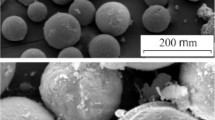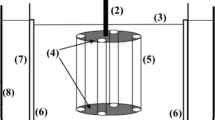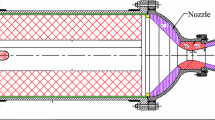Abstract
The rate of ablation in oxidative and inert media at flow velocities up to 200 m/sec has been investigated for certain epoxy compounds containing powdered copper and zinc dust. The causes of ablative destruction and the factors tending to improve the ablation resistance are examined. The contributions of mechanical erosion and thermal shock are evaluated.
Similar content being viewed by others
Explore related subjects
Discover the latest articles and news from researchers in related subjects, suggested using machine learning.References
V. A. Kirillin and A. E. Sheindlin, eds., High-Temperature Research [in Russian], Moscow, 266, 1962.
H. S. Schwartz and R. W. Farmer, Conf. on Behavior of Plastics in Advanced Flight Vehicle Environments, WADD Techn. Rep. Febr. 60, 1960.
H. A. King, Third Pacific Area National Meeting of ASTM, October 1959.
N. Bicher and R. Rozenveig, Raketnaya tekhnika,31, 4, 532, 1961.
V. P. Preobrazhenskii, Heat Technology Measurements and Instruments [in Russian], Moscow-Leningrad, 248, 1953.
V. P. Isachenko, V. A. Osipova, and A. S. Sukomel, Heat Transfer [in Russian], Moscow-Leningrad, 232, 1964.
N. V. Smirnov and I. V. Dunin-Barkovskii, Short Course of Mathematical Statistics for Technical Applications [in Russian], Moscow, 1959.
L. P. Zhilinskaite and A. N. Machyulis, Polymer Materials and their Applications [in Russian], Vilnius, 186, 1966.
A. N. Machyulis, L. P. Zhilinskaite, and M. I. Pugina, Proc. Sixth Republican Conf. on Polymer Research and Applications [in Russian], Vilnius, 70, 1965.
Author information
Authors and Affiliations
Additional information
Mekhanika Polimerov, Vol. 4, No. 1, pp. 72–77, 1968
Rights and permissions
About this article
Cite this article
Machyulis, A.N., Zhilinskaite, L.P. Ablation resistance of certain epoxy compounds. Polymer Mechanics 4, 50–56 (1968). https://doi.org/10.1007/BF00859163
Issue Date:
DOI: https://doi.org/10.1007/BF00859163




